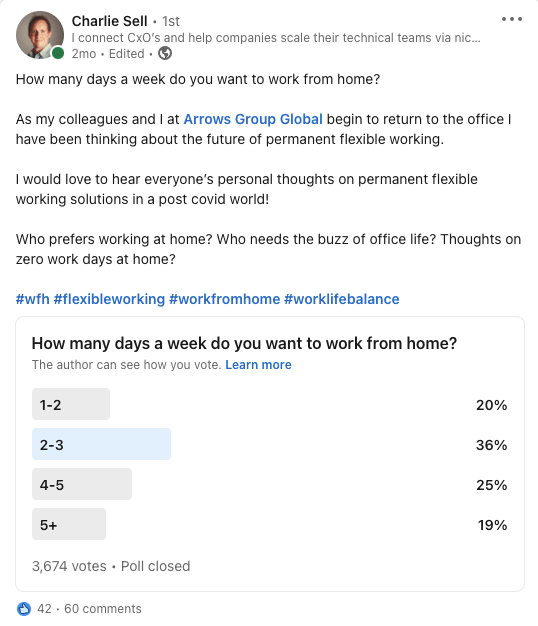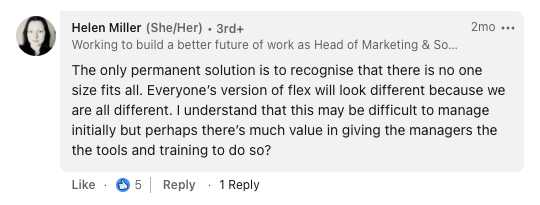If you are a frequent user of LinkedIn, you too will probably have noticed a significant volume of polls in your News Feed in recent months. These could easily be dismissed as irritating, attention-grabbing gimmicks. Having created a few polls myself recently, instead, I have been overwhelmed by the number of views and comments.
I am now re-thinking them as a useful addition to real-time business decision-making, giving extra support to choices around the rapidly changing future world of work.
The Strength of Your Network

This was the poll that kick-started it all. I asked my network how many days people would ideally like to work from home vs in the office. There were more than 3,500 votes from my followers ¬— this blew my mind!
This sort of information snapshot is important. As we navigate the new world of work, attracting and retaining staff is front of mind. With most of my LinkedIn network working in the tech sector, this is as close to polling a relevant population as I can get. It’s much more pertinent than a Google search of the same question.
Shaping Policy
I’m not suggesting LinkedIn polls should drive policy. They can be a helpful, quick dipstick. They can support an approach you’re already planning to take or spur further research. We also conduct anonymous internal staff surveys – polling everything, without causing death by poll.
Taking that first poll again as an example. It suggests the most desirable way of working right now is two to three days a week at home. This aligns with the approach we are looking at for Arrows Group. We’re asking people to come into the office two days a week, along with five flexi days a month. These flexi days are reserved for face-to-face client or team meetings outside of the normal working days.
The trick is not making it a hard rule. You can see from the results, 64% wanted a different working balance, from 1 to 5 days at home. In the comment section, several people said they would have ticked zero days at home if it was an option! We are trying to make it possible for people to choose what’s right for them. It’s not about a micro-management environment and success is not judged on physically being in an office. On the other hand, people need to be more accountable to fixed outputs when working from home, so you can judge results.

Facilitating new ways of working has also meant some important logistical changes. We are moving offices. We are changing from a location with 200 spaces to one with 100 spaces plus large events area for full-company occasions. We’ve invested in hot-desking, with people booking their space. Everyone’s moved onto laptops, lockers and ‘bring your own device’ with an app, instead of telephone landlines. A lot of this was done within a matter of weeks in March 2020, it’s now just about making it the new norm.
“The trick is not making it a hard rule … We are trying to make it possible for people to choose what’s right for them.”
Continual Listening
Polls, whether external or internal, only indicate what people are thinking right now, and we know this is a time of rapid change. In six months, the results could be different. There are also conflicting results to balance. Another poll I conducted, for example, suggested loneliness was an impact of working from home for a lot of people.
The most important thing we can do as a business is to keep listening, seeing how we can cater to the differing needs of our people and achieve our business goals.
Expect to see a few more polls from me in the future!
 Charlie Sell – Group MD, Arrows Group
Charlie Sell – Group MD, Arrows Group